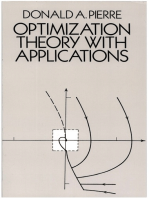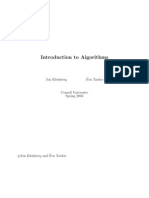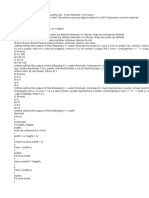Optimization_Algorithms_and_Problems
Uploaded by
jaymala.chavanOptimization_Algorithms_and_Problems
Uploaded by
jaymala.chavanOptimization and Approximation
Algorithms
Genetic Algorithm (GA)
Genetic Algorithms (GAs) are optimization algorithms inspired by the process of natural
selection. They are used to find approximate solutions to optimization and search problems.
The key components of a GA include:
1. **Population**: A set of potential solutions to the problem.
2. **Selection**: The process of selecting the fittest individuals for reproduction.
3. **Crossover**: A genetic operator used to combine the genetic information of two parents
to generate new offspring.
4. **Mutation**: A genetic operator used to maintain genetic diversity by randomly altering
the genes of an individual.
5. **Fitness Function**: A function used to evaluate how close a given solution is to the
optimum.
GAs are widely used in various fields such as engineering, economics, and artificial
intelligence to solve complex problems where traditional algorithms may fail.
Approximation Algorithms: Vertex-Cover Problem
The Vertex-Cover problem is a classical NP-complete problem where the objective is to find
the smallest subset of vertices in a graph such that each edge of the graph is incident to at
least one vertex in the subset.
An approximation algorithm for the Vertex-Cover problem provides a solution that is close
to optimal, even though finding the exact solution is computationally infeasible for large
graphs. A simple 2-approximation algorithm can be described as follows:
1. Start with an empty set C.
2. Pick an arbitrary edge (u, v) from the graph.
3. Add both u and v to C.
4. Remove all edges incident to u or v from the graph.
5. Repeat steps 2-4 until no edges remain.
This algorithm ensures that the size of C is at most twice the size of the optimal solution.
Parallel Computing Algorithms: Fast Fourier Transform (FFT)
The Fast Fourier Transform (FFT) is an algorithm used to compute the Discrete Fourier
Transform (DFT) and its inverse efficiently. FFT is widely used in various fields such as
signal processing, image processing, and solving partial differential equations.
In parallel computing, FFT can be optimized by dividing the input data among multiple
processors, allowing the computation to be performed in parallel. This reduces the time
complexity from O(n^2) to O(n log n).
Introduction to NP-Hard and NP-Complete Problems
A problem is NP-hard if solving it in polynomial time would allow us to solve all problems in
NP in polynomial time. In contrast, a problem is NP-complete if it is both in NP and as hard
as any problem in NP.
NP-complete problems are important because they represent the most difficult problems in
NP, and if any NP-complete problem can be solved in polynomial time, then all problems in
NP can also be solved in polynomial time.
Self-Learning Topics
1. **Implementation of Genetic Algorithm**: Study the components of Genetic Algorithms,
including population, selection, crossover, and mutation. Implement a GA to solve an
optimization problem.
2. **Implementation of Vertex-Cover Problem**: Implement an approximation algorithm for
the Vertex-Cover problem, and analyze its performance in terms of accuracy and efficiency.
You might also like
- Solution Manual For Algorithm Design 1st Edition Jon Kleinberg Eva Tardos98% (58)Solution Manual For Algorithm Design 1st Edition Jon Kleinberg Eva Tardos8 pages
- Introduction To Mathematical Optimization by Matteo FischettiNo ratings yetIntroduction To Mathematical Optimization by Matteo Fischetti232 pages
- Harnessing The Data Advantage in ConstructionNo ratings yetHarnessing The Data Advantage in Construction56 pages
- Patrick Siarry (Editor) - Metaheuristics-Springer (2016) PDFNo ratings yetPatrick Siarry (Editor) - Metaheuristics-Springer (2016) PDF497 pages
- DAA - Approximation Algorithm Vertex Cover - JavatpointNo ratings yetDAA - Approximation Algorithm Vertex Cover - Javatpoint1 page
- Chapter - 2: Fundamentals of Algorithmic Problem SolvingNo ratings yetChapter - 2: Fundamentals of Algorithmic Problem Solving23 pages
- Q) Matrix Chain Multiplication Problem ?: ConclusionNo ratings yetQ) Matrix Chain Multiplication Problem ?: Conclusion6 pages
- Clever Algorithms Nature Inspired Programming Recipes 1ST Edition Jason Brownlee - The ebook in PDF format is ready for download100% (1)Clever Algorithms Nature Inspired Programming Recipes 1ST Edition Jason Brownlee - The ebook in PDF format is ready for download53 pages
- Analysis And Design Of Algorithms 2nd Edition Amrinder Arora download100% (1)Analysis And Design Of Algorithms 2nd Edition Amrinder Arora download52 pages
- Fundamentals of Neural Networks What Is Neural NetNo ratings yetFundamentals of Neural Networks What Is Neural Net4 pages
- Mehlhorn K., Sanders P. Concise Algorithmics, The Basic Toolbox 124ñ PDFNo ratings yetMehlhorn K., Sanders P. Concise Algorithmics, The Basic Toolbox 124ñ PDF124 pages
- Analysis And Design Of Algorithms 2nd Edition Amrinder Arora - The ebook is available for online reading or easy downloadNo ratings yetAnalysis And Design Of Algorithms 2nd Edition Amrinder Arora - The ebook is available for online reading or easy download79 pages
- Buy ebook Analysis And Design Of Algorithms 2nd Edition Amrinder Arora cheap price100% (2)Buy ebook Analysis And Design Of Algorithms 2nd Edition Amrinder Arora cheap price71 pages
- Lecture Notes For Algorithm Analysis and Design: JNTU WorldNo ratings yetLecture Notes For Algorithm Analysis and Design: JNTU World128 pages
- Algorithms Mini Field Guide 2.0: Fast Fourier TransformNo ratings yetAlgorithms Mini Field Guide 2.0: Fast Fourier Transform5 pages
- Clever Algorithms Nature Inspired Programming Recipes 1ST Edition Jason Brownlee instant downloadNo ratings yetClever Algorithms Nature Inspired Programming Recipes 1ST Edition Jason Brownlee instant download37 pages
- Computer Vision Graph Cuts: Exploring Graph Cuts in Computer VisionFrom EverandComputer Vision Graph Cuts: Exploring Graph Cuts in Computer VisionNo ratings yet
- Our Ref: Cub/Hog/Oxd1 Payment File: RBI/id103/2014/2015: Customer ServicesNo ratings yetOur Ref: Cub/Hog/Oxd1 Payment File: RBI/id103/2014/2015: Customer Services2 pages
- Trainity Data Analytics Training Project 6No ratings yetTrainity Data Analytics Training Project 622 pages
- TLL150 Liquid Level Sensor Cut-to-Length and Calibrate: Technical DataNo ratings yetTLL150 Liquid Level Sensor Cut-to-Length and Calibrate: Technical Data1 page
- Household Cleaning Products Name of Product Active/ Major Ingredients Functions Guidelines in Using The Products Precautions in Using The ProductsNo ratings yetHousehold Cleaning Products Name of Product Active/ Major Ingredients Functions Guidelines in Using The Products Precautions in Using The Products3 pages
- Make in India, A Type of Swadeshi Movement Covering 25 Sectors of TheNo ratings yetMake in India, A Type of Swadeshi Movement Covering 25 Sectors of The9 pages
- Fond Ispitnih Pitanja Po Programu Strucne Obuke Za Procenu Rizika U Zastiti Lica Imovine I PoslovanjaNo ratings yetFond Ispitnih Pitanja Po Programu Strucne Obuke Za Procenu Rizika U Zastiti Lica Imovine I Poslovanja12 pages
- Designing Service Entrance Panelboard Equipment100% (1)Designing Service Entrance Panelboard Equipment99 pages
- Computation of Night Shift Differential PayNo ratings yetComputation of Night Shift Differential Pay3 pages
- SAP - BDT (Business Data Toolset) Developers' ManualNo ratings yetSAP - BDT (Business Data Toolset) Developers' Manual51 pages






























































































